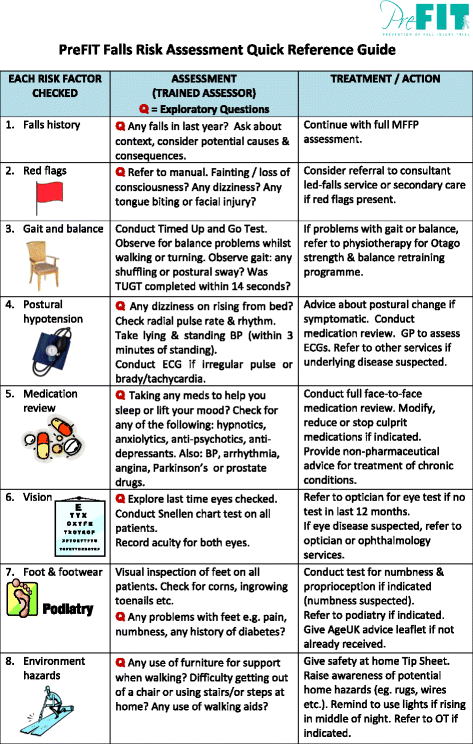What Does Dementia Fall Risk Do?
Table of ContentsGetting The Dementia Fall Risk To WorkDementia Fall Risk Things To Know Before You BuyIndicators on Dementia Fall Risk You Need To KnowDementia Fall Risk for Dummies
A fall threat evaluation checks to see just how most likely it is that you will fall. The analysis typically includes: This consists of a series of inquiries regarding your overall wellness and if you've had previous drops or issues with balance, standing, and/or strolling.STEADI includes testing, examining, and intervention. Treatments are suggestions that might decrease your danger of falling. STEADI consists of 3 steps: you for your threat of dropping for your risk elements that can be boosted to try to protect against falls (for instance, equilibrium troubles, impaired vision) to lower your risk of dropping by making use of efficient techniques (as an example, offering education and sources), you may be asked several inquiries including: Have you dropped in the previous year? Do you really feel unsteady when standing or walking? Are you stressed about falling?, your company will certainly evaluate your toughness, balance, and gait, utilizing the adhering to autumn evaluation devices: This examination checks your gait.
If it takes you 12 secs or more, it may mean you are at greater threat for a loss. This examination checks strength and balance.
The positions will certainly obtain tougher as you go. Stand with your feet side-by-side. Relocate one foot midway ahead, so the instep is touching the huge toe of your various other foot. Relocate one foot completely in front of the various other, so the toes are touching the heel of your other foot.
The Main Principles Of Dementia Fall Risk
Many drops occur as a result of numerous contributing aspects; therefore, taking care of the danger of falling starts with identifying the aspects that contribute to drop danger - Dementia Fall Risk. Some of one of the most relevant risk factors include: History of prior fallsChronic clinical conditionsAcute illnessImpaired gait and balance, reduced extremity weaknessCognitive impairmentChanges in visionCertain risky drugs and polypharmacyEnvironmental factors can also enhance the danger for drops, consisting of: Poor lightingUneven or harmed flooringWet or unsafe floorsMissing or harmed hand rails and get barsDamaged or incorrectly equipped devices, such as beds, mobility devices, or walkersImproper use assistive devicesInadequate supervision of individuals residing in the NF, consisting of those that show aggressive behaviorsA successful fall risk management program requires an extensive professional evaluation, with input from all members of the interdisciplinary group

The treatment strategy must likewise include treatments that are system-based, such as those that advertise a safe atmosphere (suitable lighting, hand rails, order bars, and so on). The effectiveness of the interventions should be evaluated periodically, and the treatment strategy changed as essential to show modifications in the loss risk assessment. Executing a fall threat monitoring system making use of evidence-based finest method can decrease the occurrence of falls in the NF, while restricting the potential for fall-related injuries.
Not known Factual Statements About Dementia Fall Risk
The AGS/BGS guideline advises screening all grownups aged 65 years and older for loss risk each year. This screening is composed of asking clients whether they have actually fallen 2 or even more times in the past year or sought clinical attention for a loss, or, click here to find out more if they have not dropped, whether they feel unstable when walking.
People that have fallen as soon as without injury ought to have their equilibrium and stride assessed; those with stride or equilibrium abnormalities need to obtain additional evaluation. A background of 1 fall without injury and without gait or equilibrium problems does not require more analysis past ongoing annual fall threat testing. Dementia Fall Risk. An autumn threat analysis is required as part of the Welcome to Medicare exam

Some Known Details About Dementia Fall Risk
Documenting a drops background is one of the top quality signs for autumn prevention and management. copyright drugs in specific are independent predictors of drops.
Postural hypotension can typically be minimized by decreasing the dosage of blood pressurelowering drugs and/or quiting drugs that have orthostatic hypotension as a side result. Use of above-the-knee support tube and copulating the head of the bed raised may likewise minimize postural reductions in high blood pressure. The advisable elements of a fall-focused physical exam are displayed in Box 1.

A yank time higher than or equivalent to 12 seconds suggests high fall risk. The 30-Second Chair Stand examination analyzes lower extremity stamina great site and equilibrium. Being incapable to stand up from a chair of knee height without making use of one's arms suggests raised loss risk. The 4-Stage Equilibrium test examines fixed balance by having the person stand in 4 placements, each progressively much more difficult.